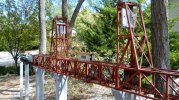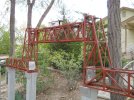ByngGiraud
Registered
Has anyone powered a lift up bridge?
I have a 1 meter access I wish to bridge.
I will try a roll up shutter motor & control, but here in Germany it would be 220 volts.
A counter balance may be necessary. If this works, I will try a 2 part bridge powered from either side of the access.
I have a 1 meter access I wish to bridge.
I will try a roll up shutter motor & control, but here in Germany it would be 220 volts.
A counter balance may be necessary. If this works, I will try a 2 part bridge powered from either side of the access.



